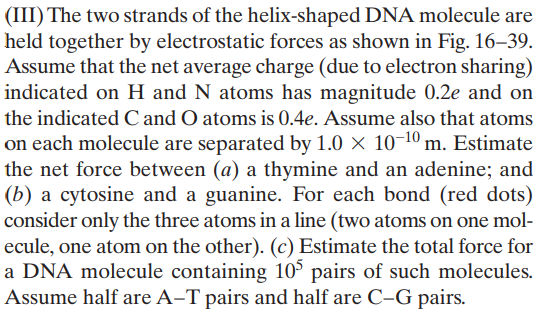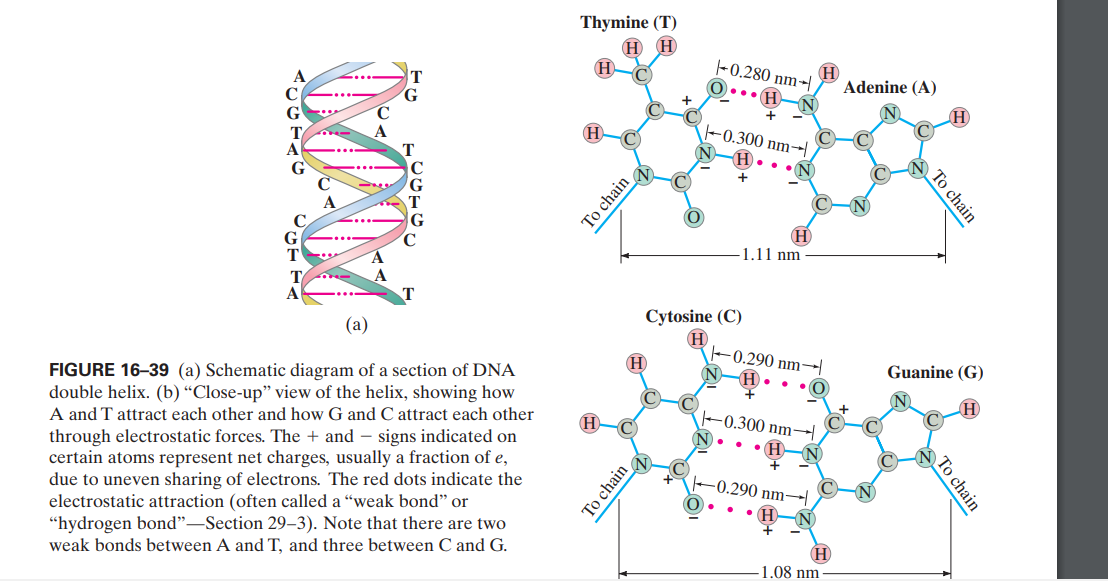(III) The two strands of the helix-shaped DNA molecule are held together by electrostatic forces as shown in Fig. 16–39. Assume that the net average charge (due to electron sharing) indicated on H and N atoms has magnitude 0.2e and on the indicated C and O atoms is 0.4e. Assume also that atoms on each molecule are separated by 1.0 × 10-10 m. Estimate the net force between (a) a thymine and an adenine; and (b) a cytosine and a guanine. For each bond (red dots) consider only the three atoms in a line (two atoms on one mol- ecule, one atom on the other). (c) Estimate the total force for a DNA molecule containing 10° pairs of such molecules. Assume half are A-T pairs and half are C-G pairs. Thymine (T) H H H |-0.280 nm- C Adenine (A) H -0.300 nm- C N H. . To chain H 1.11 nm T А (а) Cytosine (C) H -0.290 nm H FIGURE 16-39 (a) Schematic diagram of a section of DNA double helix. (b) “Close-up" view of the helix, showing how A and T attract each other and how G and C attract each other through electrostatic forces. The + and – signs indicated on certain atoms represent net charges, usually a fraction of e, due to uneven sharing of electrons. The red dots indicate the electrostatic attraction (often called a "weak bond" or “hydrogen bond"–Section 29–3). Note that there are two weak bonds between A and T, and three between C and G. Guanine (G) .. H H -0.300 nm- N -0.290 nm- (H) 1.08 nm To chain To chain To chain
(III) The two strands of the helix-shaped DNA molecule are held together by electrostatic forces as shown in Fig. 16–39. Assume that the net average charge (due to electron sharing) indicated on H and N atoms has magnitude 0.2e and on the indicated C and O atoms is 0.4e. Assume also that atoms on each molecule are separated by 1.0 × 10-10 m. Estimate the net force between (a) a thymine and an adenine; and (b) a cytosine and a guanine. For each bond (red dots) consider only the three atoms in a line (two atoms on one mol- ecule, one atom on the other). (c) Estimate the total force for a DNA molecule containing 10° pairs of such molecules. Assume half are A-T pairs and half are C-G pairs. Thymine (T) H H H |-0.280 nm- C Adenine (A) H -0.300 nm- C N H. . To chain H 1.11 nm T А (а) Cytosine (C) H -0.290 nm H FIGURE 16-39 (a) Schematic diagram of a section of DNA double helix. (b) “Close-up" view of the helix, showing how A and T attract each other and how G and C attract each other through electrostatic forces. The + and – signs indicated on certain atoms represent net charges, usually a fraction of e, due to uneven sharing of electrons. The red dots indicate the electrostatic attraction (often called a "weak bond" or “hydrogen bond"–Section 29–3). Note that there are two weak bonds between A and T, and three between C and G. Guanine (G) .. H H -0.300 nm- N -0.290 nm- (H) 1.08 nm To chain To chain To chain
Related questions
Question

Transcribed Image Text:(III) The two strands of the helix-shaped DNA molecule are
held together by electrostatic forces as shown in Fig. 16–39.
Assume that the net average charge (due to electron sharing)
indicated on H and N atoms has magnitude 0.2e and on
the indicated C and O atoms is 0.4e. Assume also that atoms
on each molecule are separated by 1.0 × 10-10 m. Estimate
the net force between (a) a thymine and an adenine; and
(b) a cytosine and a guanine. For each bond (red dots)
consider only the three atoms in a line (two atoms on one mol-
ecule, one atom on the other). (c) Estimate the total force for
a DNA molecule containing 10° pairs of such molecules.
Assume half are A-T pairs and half are C-G pairs.

Transcribed Image Text:Thymine (T)
H H
H
|-0.280 nm-
C
Adenine (A)
H
-0.300 nm-
C
N
H. .
To chain
H
1.11 nm
T
А
(а)
Cytosine (C)
H
-0.290 nm
H
FIGURE 16-39 (a) Schematic diagram of a section of DNA
double helix. (b) “Close-up" view of the helix, showing how
A and T attract each other and how G and C attract each other
through electrostatic forces. The + and – signs indicated on
certain atoms represent net charges, usually a fraction of e,
due to uneven sharing of electrons. The red dots indicate the
electrostatic attraction (often called a "weak bond" or
“hydrogen bond"–Section 29–3). Note that there are two
weak bonds between A and T, and three between C and G.
Guanine (G)
..
H
H
-0.300 nm-
N
-0.290 nm-
(H)
1.08 nm
To chain
To chain
To chain
Expert Solution
This question has been solved!
Explore an expertly crafted, step-by-step solution for a thorough understanding of key concepts.
This is a popular solution!
Trending now
This is a popular solution!
Step by step
Solved in 5 steps
